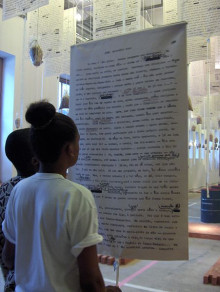Languages in Brazil
Brazil, officially the Federative Republic of Brazil, is the largest country in both South America and the Latin American region. It is the world’s fifth largest country, both by geographical area and by population. Brazil is bounded by the Atlantic Ocean on the east, with which it shares a coastline of just over 4,600 miles. As the largest country in South America, Brazil borders the majority of the other countries on that continent, including Venezuela, Guyana, Suriname and French Guiana to the north; Colombia to the northwest; Bolivia and Peru to the west; Argentina and Paraguay to the southwest; and Uruguay to the south. The only two South American countries that do not border Brazil, which occupies 47 percent of the continent, are Ecuador and Chile.
Brazil was a colony of Portugal beginning from the landing of explorer Pedro Alvares Cabral in 1500, up until 1815, when it was elevated to the rank of kingdom upon the formation of the United Kingdom of Portugal, Brazil and the Algarves. Full independence was achieved in 1822 with the formation of the Empire of Brazil, a unitary state governed under a constitutional monarchy and a parliamentary system. Brazil became a presidential republic in 1889, although the bicameral legislature, now called Congress dates back to the ratification of the first constitution in 1824. Its current constitution, drafted in 1988, defines Brazil as a federal republic. Today the Brazil federation is formed by the union of the Federal District, the 26 states, and the 5,564 municipalities.
Brazil’s proximity to its South American neighbors, its longstanding position as a Portuguese colony, and recent immigration, has greatly added to the cultural, ethnic and linguistic diversity of the nation. Below we will take a closer look at the languages spoken in Brazil, focusing primarily on the country’s official language, Portuguese, but also on some of the immigrant and indigenous languages that can still be heard in various regions of the country.
Languages Spoken in Brazil: Portuguese
 Portuguese Language Museum in São PauloLanguage is one of the most significant aspects of Brazil’s national unity and identity. Portuguese, which is the official language of Brazil, is also spoken by over 99 percent of the country’s population. However, although Portuguese is the first language for the vast majority of Brazilians, numerous foreign words have expanded the national lexicon to give the national language its own unique identity. In fact, there is roughly the same difference between the Portuguese spoken in Brazil and that spoken in Portugal as there is between the English spoken in the United States and the English spoken in the United Kingdom.
Portuguese Language Museum in São PauloLanguage is one of the most significant aspects of Brazil’s national unity and identity. Portuguese, which is the official language of Brazil, is also spoken by over 99 percent of the country’s population. However, although Portuguese is the first language for the vast majority of Brazilians, numerous foreign words have expanded the national lexicon to give the national language its own unique identity. In fact, there is roughly the same difference between the Portuguese spoken in Brazil and that spoken in Portugal as there is between the English spoken in the United States and the English spoken in the United Kingdom.
Since it was first introduced in Brazil in the 16th century, the Portuguese language has undergone many transformations, both in the mother country of Portugal and its former colony Brazil. The two countries have mostly standardized their spellings, but pronunciations, vocabularies, and the meanings of words have diverged so widely from the original tongue that it now may be easier for some Brazilians to understand Spanish-speaking people and programs from Latin American countries than people and programs from Portugal. Over the years, Italians, Germans, Japanese, and Spanish-speaking immigrants have introduced new words and expressions into what is now considered Brazilian Portuguese, such as the omnipresent expression tchau (“farewell”) that is used by Brazilians, which was originally adopted from the Italian word ciao. Foreign products and technologies have also introduced additional terms.
Within the country of Brazil, there are no distinct dialects of Portuguese, but only a modest regional disparity in things like accent, vocabulary, and the use of personal nouns, pronouns, and verb conjugations. These variations tend to ebb as a result of the nation’s mass media, especially the national television networks that are viewed by the majority of the Brazilian population.
The written form of Portuguese, which is standard throughout Brazil, follows national rules of spelling and accentuation, traits that are revised every so often for the purpose of simplification. These rules are slightly dissimilar from the rules followed in Portugal. The written form of Brazilian Portuguese varies appreciably from the verbal language and is used properly by only a small minority of the population, typically the most educated citizens. The rules of grammar tend to be very complex and permit more flexibility than, say the English or Spanish languages. As a result, many immigrants and visitors to Brazil who may have a high command of spoken Portuguese tend to have difficulty in terms of writing it properly.
Due to the enormous size of Brazil, along with its self-sufficiency, and relative isolation, foreign languages are not widely heard around the country. Like in many South American and European countries, English is often studied in school, particularly in the nation’s private schools which teach a college-preparatory curriculum. English has now replaced French in Brazil as the nation’s principal second language among educated people. Because Spanish is similar to Portuguese, most Brazilians can understand it and many can communicate in it, although Spanish speakers usually have difficulty understanding spoken Portuguese.
History of the Portuguese Language in Brazil
 Portuguese Language Museum in São PauloWhen Portugal initially colonized Brazil in the 1500s, a language known as Tupi, or more precisely Tupinambá, was used along with Portuguese as the general language of the colony. Tupinambá is one of the languages of the Tupi-Guarani family, once spoken by the Amerindians who lived on the Brazilian seacoast. The primary reason for this was because the Jesuit priests studied and taught the Tupi language as a way to communicate and evangelize.
Portuguese Language Museum in São PauloWhen Portugal initially colonized Brazil in the 1500s, a language known as Tupi, or more precisely Tupinambá, was used along with Portuguese as the general language of the colony. Tupinambá is one of the languages of the Tupi-Guarani family, once spoken by the Amerindians who lived on the Brazilian seacoast. The primary reason for this was because the Jesuit priests studied and taught the Tupi language as a way to communicate and evangelize.
In 1757, the Tupi language was banned by royal decree, although the language had already been overwhelmed by Portuguese spoken by the vast majority of immigrants that arrived from Portugal. When the Jesuits were expelled in the year 1759, Portuguese became the lingua franca, or language of the country. However, due to the exposure of Tupi and other indigenous languages, Brazilian Portuguese inherited many words associated with flora and fauna of the new land. Among these words were “abacaxi,” meaning pineapple; “mandioca,” meaning manioc flour; “caju”, meaning cashew; “tat,” meaning armadillo; “piranha,” the voracious fish; and a great number of proper and geographic names.
The Brazilian form of the Portuguese language saw new contributions with the influx of African slaves. This African influence developed largely from the Iorubá language, spoken primarily by slaves from Nigeria. Some of these words also found their way to Europe. Iorubá contributions derived from words associated with religion and the style of Afro-Brazilian cuisine. Slaves from Angola, or more precisely, the Quimbundo language they spoke, also contributed to Brazilian Portuguese. From that language a number of new words were added to the national lexicon, including cacula, meaning “youngest child;” moleque, meaning a “street child;” and the dance known as the samba.
During the 1700s, other differences between Brazilian and European Portuguese emerged. It was during this era that the Brazilian form of Portuguese failed to adopt many of the linguistic changes taking place in Portugal, most of them stemming from French influence. The Brazilian style of Portuguese maintained loyalty to the pronunciation used at the time of its discovery. However, when Don João, the Portuguese king, and the royal entourage fled to Brazil in 1808 during the Napoleonic invasion of Portugal, the King’s presence helped slightly in redirecting the Portuguese spoken in the cities of Brazil to the Portuguese used in Portugal.
After Brazilian achieved its independence in 1822, the Brazilian ilk of Portuguese became heavily influenced by the wave of Europeans who had migrated to the central and southern sections of the country. For this reason, those traveling to those specific areas of the country will discover dissimilarities in pronunciation and a small number of lexical changes, albeit most very superficial. These subtle changes reflect the different nationalities settling in each area, including Italians, Germans, Spanish and some Eastern and Northern European nationals.
As Brazil moved into the 20th century, the divide between the Portuguese spoken in Portugal and the Brazilian style of Portuguese heightened as the result of new words being introduced for technological innovations. This occurred because the Portuguese language lacked a uniform procedure for adopting such words. Certain words took on different forms and have remained so over the last century. For instance, the word “trem” in Brazil means “train,” while the Portuguese word for “train” is “comboio.” Similarly, the word “onibus” in Brazil means “bus,” while in Portugal a “bus” is referred to as an “Autocarro.”
The 21st century has seen even more changes in Brazilian Portuguese, as the nationalism and individualism of the Romantic Movement began promoting the creation of a language norm based on the Brazilian version of the Portuguese language.
Languages Spoken in Brazil: Other Languages
 Portuguese Language Museum in São PauloThere are a number of other languages spoken in Brazil, although even collectively they account for only a very small minority of the population. According to the 1940 Census, the most popular second language (after Portuguese) at the time was German. Although the percentage of Italian immigration to Brazil was much more significant than that of the Germans, the German language had many more speakers than the Italian one, according to that Census. The main reason for this was that two-thirds of the children of German immigrants spoke German at home, while half of the children of Italians spoke Portuguese at home. This illustrates the fact that the new Italian immigrants had a much easier time assimilating to the Portuguese language.
Portuguese Language Museum in São PauloThere are a number of other languages spoken in Brazil, although even collectively they account for only a very small minority of the population. According to the 1940 Census, the most popular second language (after Portuguese) at the time was German. Although the percentage of Italian immigration to Brazil was much more significant than that of the Germans, the German language had many more speakers than the Italian one, according to that Census. The main reason for this was that two-thirds of the children of German immigrants spoke German at home, while half of the children of Italians spoke Portuguese at home. This illustrates the fact that the new Italian immigrants had a much easier time assimilating to the Portuguese language.
Today there are still pockets in Brazil where the German and Italian languages can still be heard. However, these languages are rarely taught in the nation’s schools. Most second-language learners now focus on Spanish and English, two of the most widespread languages in the world.
In the large city of São Paulo, Brazil, the native languages of the Korean, Chinese and Japanese people are fairly common in the immigrant districts. A Japanese-language newspaper, the São Paulo Shinbun, has been published in the city of São Paulo since 1946. In addition to São Paulo, there is also a significant community of Japanese speakers in the cities of Paraná, Mato Grosso do Sul, Pará and Amazonas. Much smaller groups exist in Santa Catarina, Rio Grande do Sul and other parts of Brazil. Many Chinese, especially from Macau, speak a Chinese creole called Macanese (patuá or macaísta), aside from Mandarin and Cantonese.
Along with the immigrant languages that can occasionally be heard in certain sections of Brazil, dozens of discrete indigenous languages also remain. As mentioned briefly above, the Tupian, or Tupí-Guaraní, language group has especially influenced Brazilian place-names and added perhaps thousands of words and expressions to Brazilian Portuguese. Tupian was the principal language of Brazil’s native peoples before European contact, and it became the lingua franca between Indians and Portuguese traders, missionaries, adventurers, and administrators; it was widely used in the Amazon region and western Brazil until the 19th century. The Tupian influence also caused Brazilians to enunciate more clearly and to use more nasal speech patterns than their Iberian counterparts.